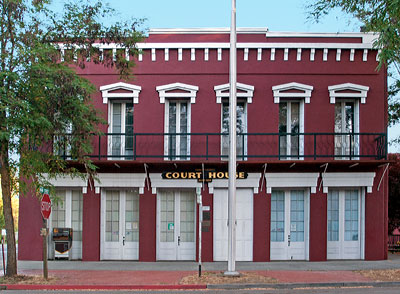National Register of Historic Places in Trinity County
 The Trinity County Courthouse is a fine example of the Italianate architectural style.
The Trinity County Courthouse is a fine example of the Italianate architectural style.
16 July 2007
(Click Photo to Zoom)
Weaverville Historic District
Main Street
Weaverville
Founded 1850
The Weaverville Historic District contains thirty-one contributing buildings on Main Street.
Weaverville is one of the best preserved towns of the Shasta-Trinity Gold Rush era. As a commercial hub, Weaverville supplied food, tools, equipment and clothing to thousands of prospectors and miners over a large section of Northern California.
Named for John Weaver in 1850, the camp of Fortyniners was the political as well as the commercial and entertainment center of Trinity County.
Early wood buildings lost in a series of disastrous fires were replaced with brick construction. By 1858 there were about twenty-five brick buildings along Main Street. Several of these buildings have an unusual circular iron stairway leading from the sidewalk to the second floor because the upper and lower stories had different owners.
A large and active Chinese population centered in a two block area where the Weaverville Joss House is located.
The thirty-one buildings which contribute to the historic district include examples of most of the architectural styles common to the Northern California gold mining towns of the 19th century. Wood two-story residences, wooden church, brick single and two story commercial building and lodge halls, a Chinese tamped earth structure, and the frame and brick Chinese temple.
Excerpted from the NRHP nomination.
| Name | Year | Address | Remarks | Sort Address | Sort Name |
|---|---|---|---|---|---|
| Whitmore House | 1899 | Building 1 | Built after the disastrous fire of 1890 | B01 | Whitmore House |
| Congregational Church | 1891 | Building 2 | The previous church, built in 1880, was destroyed in the 1890 fire except for doors, windows and furniture which were salvaged for this church. | B02 | Congregational Church |
| Highlands Art Center | 1890 | Building 3 | Residence built in the 1890's. | B03 | Highlands Art Center |
| McDonald-Files Chapel | 1860 | Building 4 | B04 | McDonald-Files Chapel | |
| Brewery | 1855 | Building 5 | B05 | Brewery | |
| Larkin's Store, Moon Lee's Store, Old Fire House | 1860 | Building 6 | A group of five buildings, remodeled for commercial use. | B06 | Larkin's Store, Moon Lee's Store, Old Fire House |
| Comstock & Martin Building | 1856 | Building 7 | B07 | Comstock & Martin Building | |
| Blacksmith Shop | 1856 | Building 8 | Modernized façade. | B08 | Blacksmith Shop |
| New York Hotel | 1859 | Building 9 | B09 | New York Hotel | |
| Edgecombe and Magnolia Buildings | 1856 | Building 10 | B10 | Edgecombe and Magnolia Buildings | |
| Anderson Building | 1855 | Building 11 | Originally it was the Davidson and Harris Drugstore | B11 | Anderson Building |
| Clifford Building (Native Sons Hall) | 1855 | Building 12 | One of the first condominiums in California with each floor having a different owner. | B12 | Clifford Building (Native Sons Hall) |
| Hocker Store | 1855 | Building 13 | B13 | Hocker Store | |
| Weaverville Hotel | 1860 | Building 14 | Built as the "Miner's Hotel," its name was later changed to "Empire Hotel." In 1915, after the top floor of the building was destroyed by fire, it was rebuilt and rechristened the Weaverville Hotel. | B14 | Weaverville Hotel |
| Bandstand | 1902 | Building 15 | B15 | Bandstand | |
| Trinity County Courthouse | 1856 | Building 16 | Prior to being purchased by the county in1865, this building had several commercial uses including a period as a saloon, | B16 | Trinity County Courthouse |
| J.S. McCain and Gettleson & Company | 1854 | Building 17 | The two buildings were combined and operated as Morris Hardware. | B17 | J.S. McCain and Gettleson & Company |
| D.M. Eder and Rhodes & Company | 1854 | Building 18 | The Eder Building was the first brick building in Weaverville. Later, it was combined with the Rhodes Building to create the store "Van Matre's." | B18 | D.M. Eder and Rhodes & Company |
| Tinnin Building | 1856 | Building 19 | Originally a hardware store and tin shop. | B19 | Tinnin Building |
| John Cole Building | 1856 | Building 20 | An early condominium. | B20 | John Cole Building |
| R.A. Fagg Building | 1856 | Building 21 | Originally the "City Drug Company." | B21 | R.A. Fagg Building |
| A. Solomon Building | 1856 | Building 22 | Originally a stove and tin ware store. After 1858, occupied by various banks. | B22 | A. Solomon Building |
| F.W. Blake Building | 1856 | Building 23 | Originally housed the F.W. Blake Bank and the Wells-Fargo Express. | B23 | F.W. Blake Building |
| Joss House | 1850 | Building 24 | B24 | Joss House | |
| J.J. "Jake" Jackson Memorial Museum and Trinity County Historical Park | Building 25 | B25 | J.J. "Jake" Jackson Memorial Museum and Trinity County Historical Park |